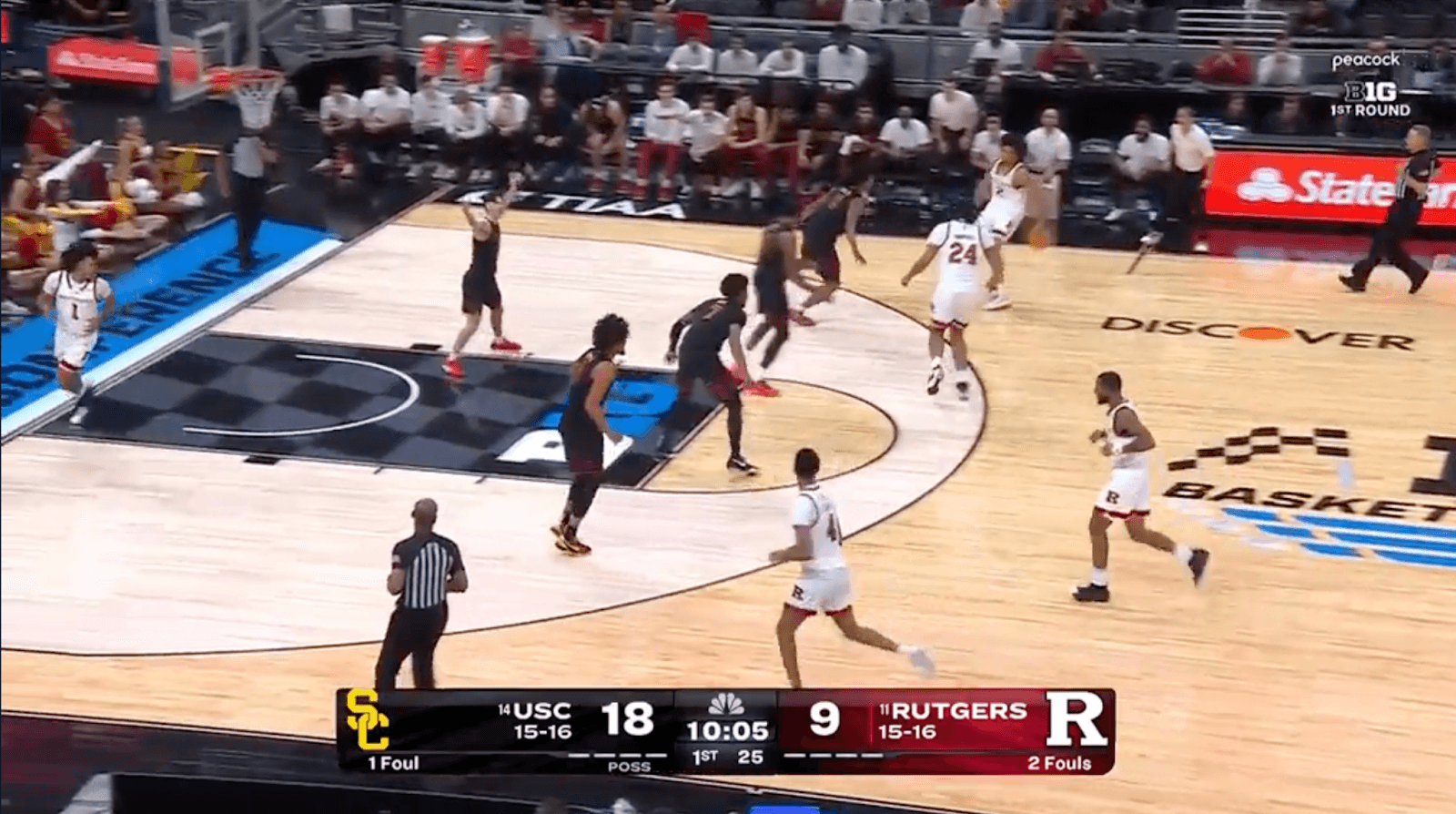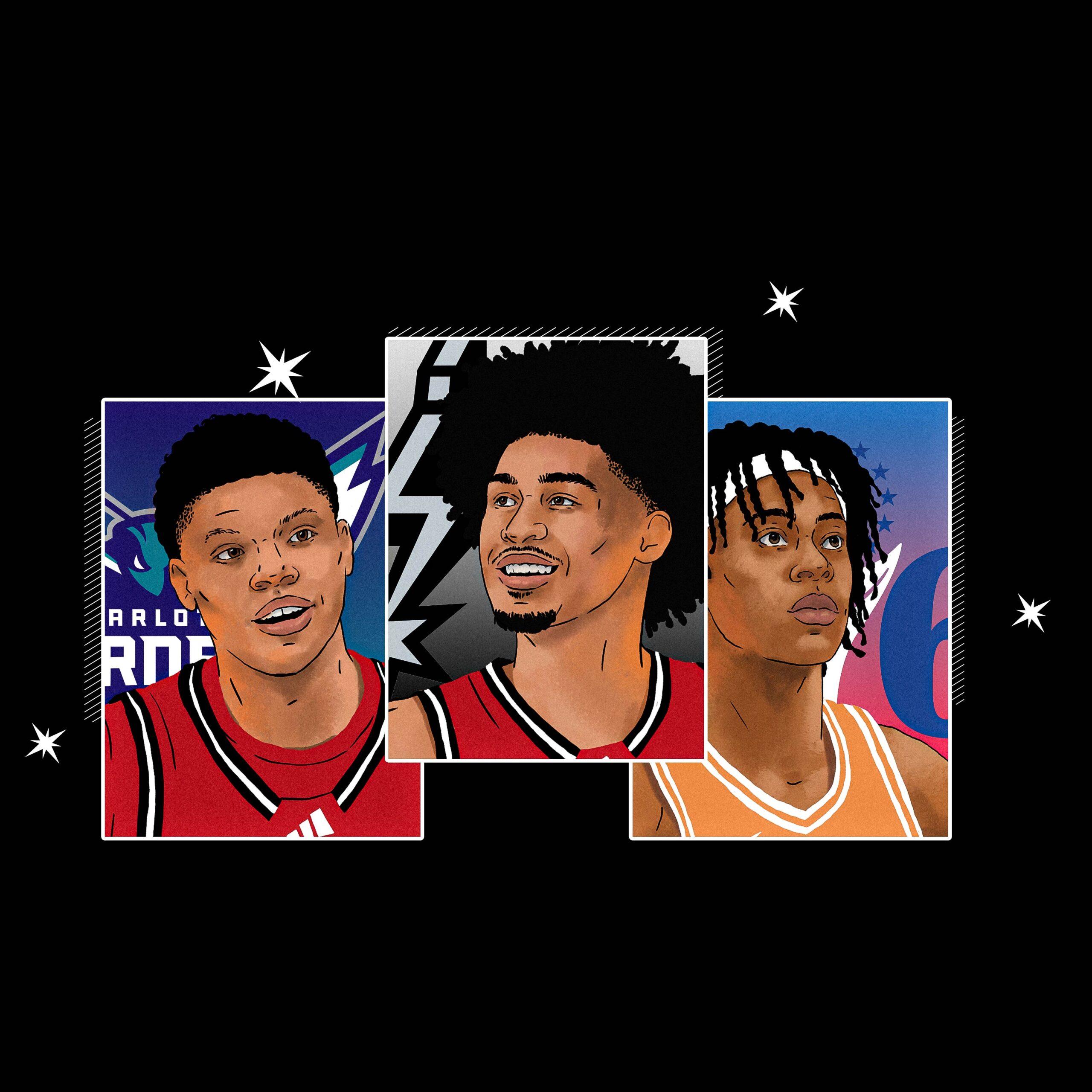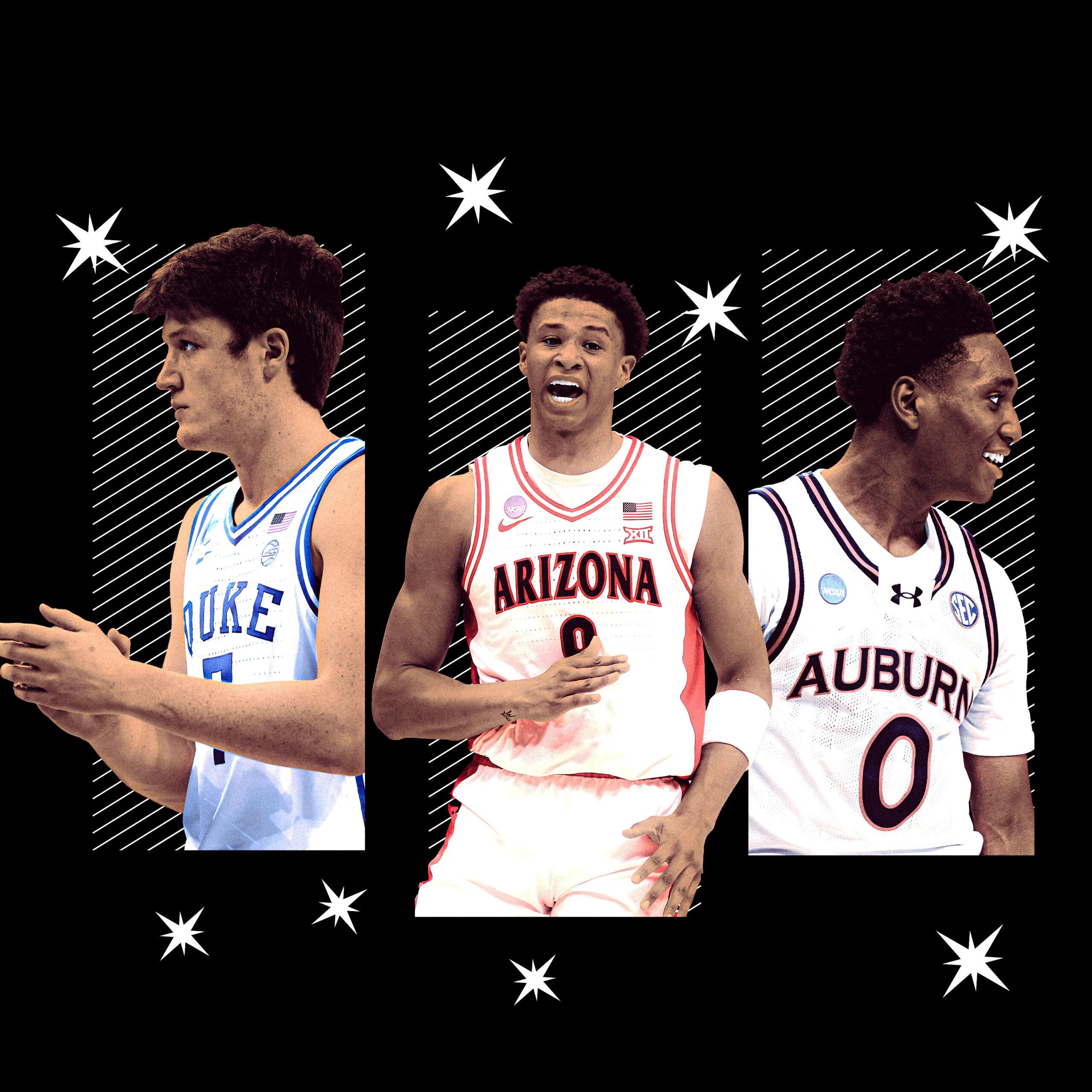With the lottery order set and Cooper Flagg’s new home now all but assured, I’ve heard the same question over and over from NBA followers who skipped out on this past college season: How on earth was Rutgers so bad with two players who might be selected in the top three?
The first thing to know is that last season’s Scarlet Knights roster, featuring Dylan Harper (the presumptive no. 2 pick) and Ace Bailey (the possible no. 3), was comically top-heavy. Hard resets happen in the transfer portal era, but this was a “hold the power button down for 20 seconds” reboot. Rutgers coach Steve Pikiell lost 10 players to the portal last offseason, and the incoming transfers were all low-impact players imported from schools like Merrimack, Princeton, San Diego, and Eastern Michigan. The remaining seven spots were filled by freshmen. Harper and Bailey were both ranked in the top three of the 2024 high school class (Flagg, of course, was the top dog), but three other Rutgers signees were ranked between no. 117 and no. 206, and the remaining three were unranked.
I could go into the details of what the team lacked, but they’ve suffered enough. So I’ll get right to the point: The average net rating for the lineups that consisted of neither Bailey nor Harper, according to CBB Analytics, was minus-12.
It was an unfortunate situation, but not altogether uncommon: There have been a few great prospects in recent history who have floundered in college because of stinky supporting casts. Anthony Edwards chucking jumpers on an awful Georgia team. Ben Simmons carried a huge load for an abysmal LSU team that went 19-14 and missed the NCAA tournament. Markelle Fultz helmed a Washington team that had a similar lopsidedness of talent and essentially led to coach Lorenzo Romar’s firing.
There are more: Jett Howard and Kobe Bufkin (both first-rounders, both looking rougher by the moment) played on a blech Michigan team, Dennis Smith Jr. at NC State, GG Jackson at South Carolina, on and on.
That’s a concerning list (minus Edwards), especially considering the Scarlet Knights had two top prospects instead of one. But this Rutgers team was uniquely bad—worse, in fact, than most of the teams that we’ve mentioned here. Is that enough of an excuse to simply set the concerns aside?
That’s just one of the many questions the Spurs and 76ers will be asking ahead of draft night, including whether to even keep the nos. 2 and 3 picks. With Flagg’s fate decided, the draft now shifts its gaze to New Jersey, and whether this pair of teammates could (and should) come off the board next.
The Case for Harper at No. 2
Very few aspiring on-ball superstars come into the league with the perfect repertoire. Luka Doncic was the exception to the rule, but even the Wonder Boy faced questions about whether he could consistently hit pull-up 3s. For every other prospect, there’s a strength and then there’s a weakness that needs improvement, and teams cross their fingers and hope that it all balances out by their mid-to-late 20s in the way it has for players like Steph Curry, Jayson Tatum, James Harden, and Tyrese Haliburton.
For Harper, his strength on offense is glaringly obvious: He has an incredibly advanced sense for pace, timing, and angles, and how to deploy those traits with physicality and footwork. It’s very difficult to speed him up, which is not something you can really learn by the time you become a pro. “Cade Cunningham spliced with Jalen Brunson” comes to mind when watching Harper, and there are also some glimmers of Shai Gilgeous-Alexander’s phenomenal ability (even as a prospect) to, somehow, always get to the rim and make something happen. For that reason, it’s easy to imagine Harper generating a metric ton of free throws like the presumptive MVP.
Harper’s command of the floor is apparent beyond the arc, whether it’s patiently setting up his defender to be screened or the way he’s able to prepare a driving lane for himself without doing a ton of side-to-side dancing with the ball. But those tools really shine in the paint. Harper is a ruggedly built, broad-shouldered lead guard who measured 6-foot-4.5 (without shoes) with a 6-foot-10 wingspan at the NBA scouting combine, but what’s really striking is his balance. We gush over the balletic feats of midair improvisors, but Harper’s brilliance stems from his measuredness and presence of mind. And he has time to think the game at such a high level because you cannot push this fucking guy around in the paint.
Nearly a third of Harper’s offense at Rutgers came in the restricted area, and he converted a staggering 73.3 percent of his 131 attempts at the rim—in an offense with no spacing. Harper showed some live-dribble passing chops when the windows presented themselves and teammates streaked to the rim from the corners, but his ability to hold his ground against physicality also created opportunities for him to dump off dimes to teammates in tight spaces.
Those windows became minuscule as opposing coaches gathered data on Rutgers’s unbalanced roster. Spacing is created based on a defense’s respect for your shooters, and Harper’s supporting cast got very little of it. By February, teams like Purdue and USC were forcing him to see more bodies than a mosh pit of old millennials at a post-punk reunion show when he turned a corner to drive. This is basically a Giannis Wall:

On the one hand, it’s a little troubling that Harper, a player who aspires to be a primary creator in the NBA, could be rendered inert by simply taking away one silo of his game. On the other, he did still produce. Ultimately, those coverages were a gift, as he’s going to be seeing a lot of them in the future. If the ball is in the lefty guard’s hands a lot, defenses are going to load to the left side of the floor and hug the paint to bait him into choosing less efficient alternatives.
Overcoming this and powering forward on the path toward primary option status will come down to two things. The first is strengthening his off hand. Harper often gets very low to the ground with his left hand and pounds the damn thing like a jackhammer. Going to his right, there are nits to pick: He could pass out of traps faster instead of bringing his left hand to the ball, or getting lower with his dribble in traffic to avoid help defenders who want to swipe at the ball.
The other factor is the shooting. Cerebro Sports is a stats database that pulls in events from all levels across years of competition, and going back to 2021, they clock Harper with 532 3-point attempts in events ranging from grassroots summer ball to exhibition high school games to structured settings like Rutgers. They also have him logged at 174 makes, which would place him as a 32.7 percent 3-point shooter on a pretty credible sample.
A lack of help meant a lack of easy looks, but Harper’s mechanics seemed to lose consistency when he was on the move with a live dribble. His arc was noticeably flatter and the ball would often sail long, with a lot of his misses finding the rim in a way that was not conducive to bouncing in. Of the 155 3-pointers he got off at Rutgers, 96 of them were off the dribble, and he hit only 29.2 percent of those. Getting off the ball earlier and being fed catch-and-shoot looks from better teammates could go a long way toward improving his percentages.
The question for the Spurs, ultimately (and assuming they pick him), is how long do they want to wait to see whether Harper can work his way through these obstacles.
In recent years, San Antonio has preferred to draft perimeter size that leans toward defense with offense that could use some time to grow, rather than the other way around. Stephon Castle (2024), Devin Vassell (2020), Jeremy Sochan (2022), and Keldon Johnson (2019) are all in that 6-foot-5 to 6-foot-8 range, and each of them sports a wingspan at least 3 inches longer than their listed height. Mix in lean strength and mobility and you’ve got a blueprint for immense defensive switchability in the 1-through-4 range, with a French guy who has a chance to be one of the best defensive anchors of all time overseeing everything. Based on physical profile alone, Harper absolutely fits what the Spurs like to do with their picks.
But the Spurs might also be at capacity with that type of player—especially given the spatial questions it could present on offense. Castle is a menace defensively and a stone-cold killer inside the arc, but shooting remains a concern for the newly minted Rookie of the Year. The same is true for Sochan, and while Johnson’s numbers were fine coming into the league, he’s failed to really graduate to knockdown status. Vassell has been the only truly consistent shooter in the group. If the Spurs see a cloudy future for Harper as a shooter, it may only complicate life for Victor Wembanyama and De’Aaron Fox, the point guard they just paired with him at this year’s trade deadline.
The answer at no. 2 may ultimately come down to a timeline. If the Spurs are willing to sacrifice some long-term flexibility, they could package the pick along with some of their other young pieces and take a huge swing at a win-now player. Obviously, Giannis Antetokounmpo is the recurring name being brought up as a target, and his fit next to Wembanyama could pay historic dividends. While I do think that Harper will be productive (possibly even highly productive) in the short term, playoff standards are very high, and Harper would likely be put in a more limited, controlled role in a series.
My bottom-line outlook is that Harper’s most likely outcome is as the second guy on a very good team, but he has the tools to smooth out those areas where growth needs to happen. In either scenario, I see him as the kind of crucial building block you want if you’re a team that’s starting over. Which might be a better description for the Bucks after dealing Giannis than it would for a Spurs team already on the precipice of breaking through.
The Case for Bailey at No. 3
The Sixers were given a rare gift in the draft lottery. How often is an old and increasingly expensive team handed an opportunity to land a top-three rookie talent? But now comes the hard part: If Philadelphia keeps the pick, it will need to find the right player who can strike a balance between playing a role now and having the upside to do more in the long term.
In a lot of ways, that overarching question mirrors the existential debate raging within Bailey’s draft profile.
Bailey is the kind of shooter who could open up all kinds of opportunities for a healthy version of the Sixers’ Big Three. He shot 38.7 percent on catch-and-shoot looks overall last season, and 43.9 percent from 3 when contested on those shots. When Rutgers’s cramped offense allowed it, Ace also flashed to open space and canned a jumper, or sneaked behind the defense for a big finish. He can shoot, he can cut, and he can hit late-clock jumpers when the offense is in a bind and just needs to generate something easy. In a lot of ways, he’s a great fit to play a role.
But Bailey’s long-term ceiling is a more complicated discussion, one that starts with the need to make a significant ballhanding leap. He can look like a smooth and competent handler away from contact, but the control gets very dicey once pressure enters the picture. This is partly because he’s still very thin for his size. But it’s also partly due to the simple fact that his ball control could use some tightening. Because of these issues, his decision tree with the ball often shrinks down to “Can I score? Hope so, because this is all I got.”
At this point, Bailey’s self-generated offense comes off simple actions: a straight-line drive to an open lane, a jumper created from minimal dribbling, or often standstill, no-dribble, one-on-one situations where he rises up and over the defender for a jumper. He might even sell a stutter rip-through and, if space is created, pull it back and take the early jumper. There are times when he makes a handful of these shots and entire arenas gasp at the talent it takes to not only make it, but make it cleanly.
There are also times when Ace’s methods for getting to his spots are thwarted, and instead of finding a teammate he goes into a tunnel-visioned zone where everyone else disappears like in the soloist sequence from the movie Soul. Unfortunately, when he snaps out of it, his bandmates aren’t in awe. It’s no surprise, then, that Bailey was in the 7th percentile in assist-to-usage among players at his position.
Bailey’s “one step, jump” superpower is the driving force behind most of the things he does well, including defense. He fits the big wing template but he doesn’t have the fantastical size and wingspan that many were led to believe: He recently measured at just over 6-foot-7 (so about 6-foot-9 in shoes) with a 7-foot wingspan at the combine. That said, he’s tremendously fast off his feet and (much like Flagg) reaches the high point of his jump very quickly. Check out the opening tip from Rutgers’s late February game against Michigan, where Ace jumped against Vlad Goldin, a legitimate 7-footer. He closes on gaps between his contest and the ball in a flash, which is a big reason his block percentage was 4.1, exceptional for a wing.
In sequences like these, you can see the simple but enticing vision: wiry limbs breaking up lobs or flying in to contest cutters and/or rollers attempting to finish at the rim. It’s even better when he corrals the swatted shot, sprints in the other direction, and cashes a 3 in transition or boings for an alley-oop. But the drool-inducing highlights are harder to find when Bailey has to move laterally. He doesn’t have the same level of twitchiness in his hips that similar-sized players like Carter Bryant or Collin Murray-Boyles do, so he might not become the kind of stopper a coach can assign to an opponent’s best perimeter scorer.
Bailey’s self-scouting report is a little more … to the point: “Ain’t got no weaknesses, and I got more than two strengths, big dog,” he recently told the ESPN booth at the combine when asked specifically to name two strengths.
Ace clearly doesn’t lack confidence. But that level of self-belief can have highs and lows. I think back to this sequence during Rutgers’s entertaining road loss at Indiana, when Bailey went off for 39 points while Harper sat with an illness. At a key spot in the second half, Bailey missed two free throws that would’ve cut into the Hoosiers’ growing lead. Didn’t faze him. Moments later, he ran off a couple of screens, controlled his momentum, and twisted to his right as he jumped what seemed like a foot in the air to nail one of the more ridiculous contested 3s I’ve ever seen a college player make. One Rutgers assistant turned to look at the rest of the bench, his mouth agape. Another leaned forward and wearily put his hand on his face. That whiplash between “no one else can do that” and “why would you do that” sums up why Bailey remains so tantalizing.
Tough shot-making is extremely fun; it warped a generation of basketball fans to think that the game is about the triumph of the individual. But it’s a tough way to live in the NBA without having other ways to affect a game. If you believe Daryl Morey that the Sixers are capable of giving it another go next season if Joel Embiid is healthy, those “other” skills might be the primary ways Bailey or whomever gets the nod at no. 3 will be able to impact winning.
Of course, Morey could also opt out of making the first top-10 pick of his nearly two-decade career. Philly could easily ship the pick to a team dying for a potential star in exchange for a later pick and a veteran player. Brooklyn (no. 8) and New Orleans (no. 7) both fit that as potential trade partners. Or what if the Spurs, whose draft boards often zag against conventional wisdom, decide to take Bailey at no. 2? Rather than try to force another lead ball handler into its backcourt, San Antonio could draft Ace to pull attention away from Wembanyama with his shooting gravity and wreak havoc as a help defender in the long shadow of Wemby’s Nosferatu limbs.
Drafting for need this high in the draft would be a mild shock, but there also isn’t much precedent for two teams expecting to contend next season holding top-three picks in a loaded class. So much is in play once Flagg is off the board. Whether Harper or Bailey goes next is still to be determined, but the Rutgers teammates figure to be right in the middle of all the predraft commotion.


